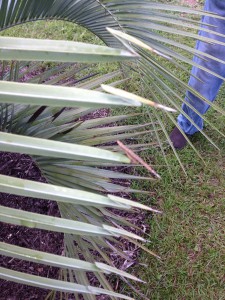Palms can be difficult to manage in Northwest Florida. To have healthy palms it is important to think about possible cold temperatures, disease, and nutrient needs of palms. The panhandle of Florida was blasted with cold this winter and it is easy to see the effects on the palms. There are many palms throughout Northwest Florida which appear or are dead. This article will give information on several of the pesky palm problems observed throughout the region and some recommendations to help!
Cold damage is evident right now from this past winters’ very harsh temperatures. Some recommendations to help alleviate this problem include selection of the proper species. Some palms are not suited for colder temperatures and this must be taken in to account or you will continue to have problems even during mild winters. Look at the publication that has a table of palm suited for north Florida: Palms for North Florida
Next, develop a plan of action if your palm has been effected by cold damage. As has been seen throughout the panhandle, freeze damage can make an entire palm canopy turn brown and desiccate (dry out). It can even go as far as killing the spear leaf (The newly emerging palm leaf that resembles a spear). Even if the spear leaf has died and easily pulls out of the canopy, the palm may not be dead. If the meristem (the area of replicating cells that new leaves emerge from) survives the palm will also survive. If the spear leaf does die, give the palm 5-6 months to send out a new leaf before declaring it dead.

Another issue that may arise in the near future with the recent heavy rains is Boron deficiency of palms. Boron deficiency can be cause by leaching of soil Boron out of the root zone by heavy rain falls or heavy irrigation. When Boron has been leached from the soil it causes an acute (temporary) deficiency that will only last until microorganisms have time to break down more soil organic material that releases more Boron to the palm. Symptoms include small and crumpled new leaves, angular leaf tips, “hook-leaf”, and sometimes the stem bends sharply to one side. The symptoms won’t be visible for 4 to 5 months as the deficiency affects the leaf during development prior to its emergence. By the time it is seen the problem has probably already been corrected.

Also, chronic (long-lasting) Boron deficiency problems can occur on palms. This deficiency is usually caused by soil drying and high soil pH. If there is a chronic Boron deficiency a drench can be applied to correct the problem. Learn more about Boron Deficiency of Palms
 0
0
